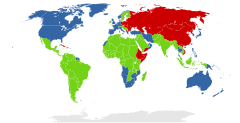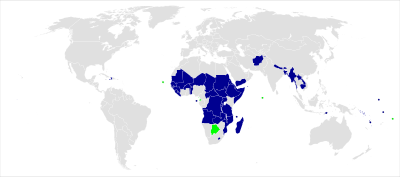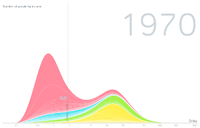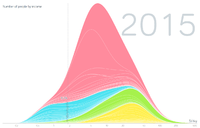Third World
The term "Third World" arose during the Cold War to define countries that remained non-aligned with either NATO or the Communist Bloc. The United States, Canada, Japan, South Korea, Western European nations and their allies represented the First World, while the Soviet Union, China, Cuba, and their allies represented the Second World. This terminology provided a way of broadly categorizing the nations of the Earth into three groups based on political and economic divisions. Since the fall of the Soviet Union and the end of the Cold War, the term Third World has been used less and less. It is being replaced with terms such as developing countries, least developed countries or the Global South. The concept itself has become outdated as it no longer represents the current political or economic state of the world.

The Third World was normally seen to include many countries with colonial pasts in Africa, Latin America, Oceania and Asia. It was also sometimes taken as synonymous with countries in the Non-Aligned Movement. In the dependency theory of thinkers like Raúl Prebisch, Walter Rodney, Theotonio dos Santos, and Andre Gunder Frank, the Third World has also been connected to the world-systemic economic division as "periphery" countries dominated by the countries comprising the economic "core".[1]
Due to the complex history of evolving meanings and contexts, there is no clear or agreed-upon definition of the Third World.[1] Some countries in the Communist Bloc, such as Cuba, were often regarded as "Third World". Because many Third World countries were economically poor, and non-industrialized, it became a stereotype to refer to poor countries as "third world countries", yet the "Third World" term is also often taken to include newly industrialized countries like Brazil, India and China now more commonly referred to as part of BRIC. Historically, some European countries were non-aligned and a few of these were and are very prosperous, including Ireland, Austria, Sweden, Finland, Switzerland and Yugoslavia.
Etymology
French demographer, anthropologist and historian Alfred Sauvy, in an article published in the French magazine L'Observateur, August 14, 1952, coined the term Third World (French: Tiers Monde), referring to countries that were unaligned with either the Communist Soviet bloc or the Capitalist NATO bloc during the Cold War.[2] His usage was a reference to the Third Estate, the commoners of France who, before and during the French Revolution, opposed the clergy and nobles, who composed the First Estate and Second Estate, respectively. Sauvy wrote, "This third world ignored, exploited, despised like the third estate also wants to be something."[3] He conveyed the concept of political non-alignment with either the capitalist or communist bloc.[4]
Third World vs. Three Worlds
The "Three Worlds Theory" developed by Mao Zedong is different from the Western theory of the Three Worlds or Third World. For example, in the Western theory, China and India belong respectively to the second and third worlds, but in Mao's theory both China and India are part of the Third World which he defined as consisting of exploited nations.
Third Worldism
Third Worldism is a political movement that argues for the unity of third-world nations against first-world influence and the principle of non-interference in other countries' domestic affairs. Groups most notable for expressing and exercising this idea are the Non-Aligned Movement (NAM) and the Group of 77 which provide a base for relations and diplomacy between not just the third-world countries, but between the third-world and the first and second worlds. The notion has been criticized as providing a fig leaf for human-rights violations and political repression by dictatorships.[5]
History
Most Third World countries are former colonies. Having gained independence, many of these countries, especially smaller ones, were faced with the challenges of nation- and institution-building on their own for the first time. Due to this common background, many of these nations were "developing" in economic terms for most of the 20th century, and many still are. This term, used today, generally denotes countries that have not developed to the same levels as OECD countries, and are thus in the process of developing.
In the 1980s, economist Peter Bauer offered a competing definition for the term "Third World". He claimed that the attachment of Third World status to a particular country was not based on any stable economic or political criteria, and was a mostly arbitrary process. The large diversity of countries considered part of the Third World — from Indonesia to Afghanistan — ranged widely from economically primitive to economically advanced and from politically non-aligned to Soviet- or Western-leaning. An argument could also be made for how parts of the U.S. are more like the Third World.[6]
The only characteristic that Bauer found common in all Third World countries was that their governments "demand and receive Western aid," the giving of which he strongly opposed. Thus, the aggregate term "Third World" was challenged as misleading even during the Cold War period, because it had no consistent or collective identity among the countries it supposedly encompassed.
Development aid

During the Cold War, unaligned countries of the Third World[1] were seen as potential allies by both the First and Second World. Therefore, the United States and the Soviet Union went to great lengths to establish connections in these countries by offering economic and military support to gain strategically located alliances (e.g., United States in Vietnam or Soviet Union in Cuba).[1] By the end of the Cold War, many Third World countries had adopted capitalist or communist economic models and continued to receive support from the side they had chosen. Throughout the Cold War and beyond, the countries of the Third World have been the priority recipients of Western foreign aid and the focus of economic development through mainstream theories such as modernization theory and dependency theory.[1]
By the end of the 1960s, the idea of the Third World came to represent countries in Africa, Asia and Latin America that were considered underdeveloped by the West based on a variety of characteristics (low economic development, low life expectancy, high rates of poverty and disease, etc.).[2] These countries became the targets for aid and support from governments, NGOs and individuals from wealthier nations. One popular model, known as Rostow's stages of growth, argued that development took place in 5 stages (Traditional Society; Pre-conditions for Take-off; Take-off; Drive to Maturity; Age of High Mass Consumption).[7] W. W. Rostow argued that Take-off was the critical stage that the Third World was missing or struggling with. Thus, foreign aid was needed to help kick-start industrialization and economic growth in these countries.[7]
Great Divergence and Great Convergence


Many times there is a clear distinction between First and Third Worlds. When talking about the Global North and the Global South, the majority of the time the two go hand in hand. People refer to the two as "Third World/South" and "First World/North" because the Global North is more affluent and developed, whereas the Global South is less developed and often poorer.[8]
To counter this mode of thought, some scholars began proposing the idea of a change in world dynamics that began in the late 1980s, and termed it the Great Convergence.[9] As Jack A. Goldstone and his colleagues put it, "in the twentieth century, the Great Divergence peaked before the First World War and continued until the early 1970s, then, after two decades of indeterminate fluctuations, in the late 1980s it was replaced by the Great Convergence as the majority of Third World countries reached economic growth rates significantly higher than those in most First World countries".[10]
Others have observed a return to Cold War-era alignments (MacKinnon, 2007; Lucas, 2008), this time with substantial changes between 1990–2015 in geography, the world economy and relationship dynamics between current and emerging world powers; not necessarily redefining the classic meaning of First, Second, and Third World terms, but rather which countries belong to them by way of association to which world power or coalition of countries — such as G7, the European Union, OECD; G20, OPEC, BRICS, ASEAN; the African Union, and the Eurasian Union.
See also
- Fourth World
Notes
- Tomlinson, B.R. (2003). "What was the Third World", Journal of Contemporary History, 38(2): 307–321.
- Gregory, Derek et al. (Eds.) (2009). Dictionary of Human Geography (5th Ed.), Wiley-Blackwell.
- Literal translation from French
- Wolf-Phillips, Leslie (1987). "Why 'Third World'?: Origin, Definition and Usage", Third World Quarterly, 9(4): 1311-1327.
- Pithouse, Richard (2005). Report Back from the Third World Network Meeting Accra, 2005. Centre for Civil Society : 1-6.
- "Third World America", MacLeans, September 14, 2010
- Westernizing the Third World (Ch 2), Routledge
- Mimiko, Oluwafemi (2012). "Globalization: The Politics of Global Economic Relations and International Business". Carolina Academic Press: 49.
- Korotayev A., Zinkina J. On the structure of the present-day convergence. Campus-Wide Information Systems. Vol. 31 No. 2/3, 2014, pp. 139-152
- Phases of global demographic transition correlate with phases of the Great Divergence and Great Convergence. Technological Forecasting and Social Change. Volume 95, June 2015, Page 163.
Further reading
- Aijaz, Ahmad (1992). In theory: Classes, nations, literatures. London: Verso.
- Bauer, Peter T. (1981). Equality, the Third World, and economic delusion. Cambridge, MA: Harvard University Press.
- Buchanan, Pat J. (2006). State of emergency: The Third World invasion and conquest of America. New York: Thomas Dunne Books/St. Martin's Press.
- Escobar, Arturo (2011). Encountering development: The making and unmaking of the Third World (revised ed.). Princeton, NJ: Princeton University Press.
- Furtado, Celso (1964). Development and underdevelopment. Berkeley: University of California Press.
- Huffington, Arianna S. (2010). Third World America: How our politicians are abandoning the middle class and betraying the American dream. New York: Crown Publishers.
- Melkote, Srinivas R. & Steeves, H. Leslie. (1991). Communication for development in the Third World: Theory and practice for Empowerment. New Delhi: SAGE Publications.
- Sheppard, Eric & Porter, Wayland P. (1998). A world of difference: Society, nature, development. New York: Guilford Press.
- Rangel, Carlos (1986). Third World Ideology and Western Reality. New Brunswick: Transaction Books.
- Smith, Brian C. (2013). Understanding Third World Politics: Theories of Political Change and Development (4th ed.). London: Palgrave Macmillan.
- Aijaz, Charles K. (1973). The political economy of development and underdevelopment. New York: Random House.
| Wikiquote has quotations related to: Third World |
| Wikimedia Commons has media related to Third World. |